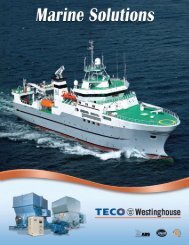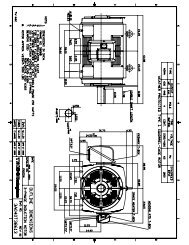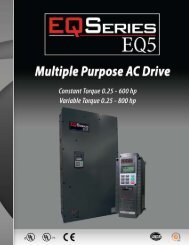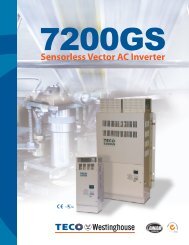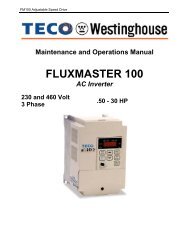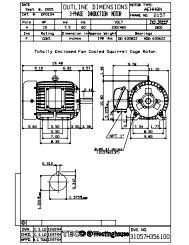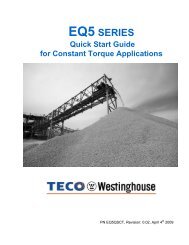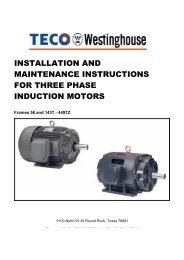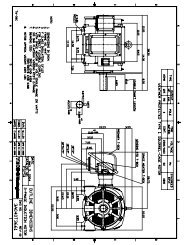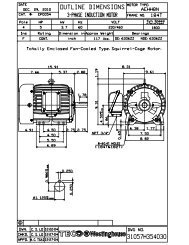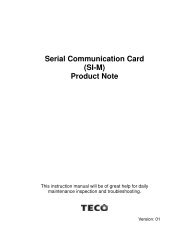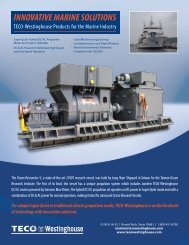EQ7 Series Instruction Manual - TECO-Westinghouse Motor Company
EQ7 Series Instruction Manual - TECO-Westinghouse Motor Company
EQ7 Series Instruction Manual - TECO-Westinghouse Motor Company
Create successful ePaper yourself
Turn your PDF publications into a flip-book with our unique Google optimized e-Paper software.
Factory default: By factory default, H13 is set to a matched value for the standard motor (see Table A in Section<br />
5.1 "Function Code Tables"). Basically, it is not necessary to change H13 data. However, if the long restart time<br />
causes deteriorated performance or causes any other problem, reduce the setting to about a half of the default<br />
value, ensuring that no alarm occurs.<br />
Function code H13 (Restart mode after momentary power failure -- Restart time) also applies to the<br />
switching operation between line and inverter (refer to the descriptions of E01 through E07).<br />
• Restart mode after momentary power failure (Frequency fall rate) (H14)<br />
During restart after a momentary power failure, if the inverter output frequency and the idling motor speed cannot<br />
be harmonized with each other, an overcurrent persists, activating the overcurrent limiter. If it happens, the<br />
inverter automatically reduces the output frequency to match the idling motor speed according to the reduction<br />
rate (Frequency fall rate: Hz/s) specified by H14.<br />
Data for H14<br />
Inverter’s action for the output frequency fall<br />
0.00 Follow the deceleration time specified<br />
0.01 to 100.00 (Hz/s) Follow data specified by H14<br />
999<br />
Follow the setting of the PI controller in the current limiter.<br />
(The PI constant is prefixed inside the inverter.)<br />
If the frequency drop rate is too high, regeneration may take place at the moment the motor rotation<br />
matches the inverter output frequency, causing an overvoltage trip. On the contrary, if the frequency fall<br />
rate is too low, the time required for the output frequency to match the motor speed (duration of current<br />
limiting action) may be excessive, triggering the inverter overload prevention control.<br />
• Restart after momentary power failure (Continuous running level) (H15)<br />
Continuity of running (P and I) (H92, H93)<br />
• Trip after decelerate-to-stop<br />
If a momentary power failure occurs when F14 is set to "2" (Trip after decelerate-to-stop), the inverter enters the<br />
control sequence of the decelerate-to-stop when the DC link bus voltage drops below the continuous running level<br />
specified by H15.<br />
Under the decelerate-to-stop control, the inverter decelerates its output frequency keeping the DC link bus voltage<br />
constant using the PI processor. (P (proportional) and I (integral) components of the PI processor are specified by<br />
H92 and H93, respectively.)<br />
For normal inverter operation, it is not necessary to modify H15, H92 or H93.<br />
• Continue to run<br />
If a momentary power failure occurs when F14 is set to "3" (Continue to run), the inverter enters the control<br />
sequence of the continuous running when the DC link bus voltage drops below the continuous running level<br />
specified by H15.<br />
Under the continuous running control, the inverter continues to run keeping the DC link bus voltage constant using<br />
the PI processor. (P (proportional) and I (integral) components of the PI processor are specified by H92 and H93,<br />
respectively.) For normal inverter operation, it is not necessary to modify H15, H92 or H93.<br />
Power supply voltage<br />
<br />
40 HP or below 50 HP or above<br />
230 V series 5 V 10 V<br />
460 V series 10 V 20 V<br />
4-48



